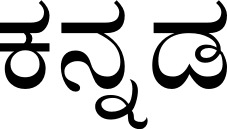When you first start, it will appear to be extremely difficult to master. It is, in fact, unusual, and you must adjust to the differences. It’s fairly simple once you’ve gotten beyond the first major obstacle.
The Kannada script is an abugida of the Brahmic family that is predominantly used to write Kannada, a Dravidian language spoken predominantly in the state of Karnataka in South India. In Karnataka, the Kannada script is employed to write Sanskrit texts. Tulu, Konkani, Kodava, Havyaka, Sanketi, and Beary are only a few of the minor languages that employ the Kannada alphabet.
Experts agree that the Kannada writing system is difficult to master. Because the language uses 49 phonetic letters divided into three groups: “Swaragalu vowels” – thirteen letters; “Vyanjanagalu consonants” – thirty-four letters; and “Yoga vaahaka galu” (neither vowel nor consonant) – two letters: “anusvara and visarga”. This set of characters are almost identical to other Indian languages and the number of written symbols is far more than 49 characters in the alphabets.
Kannada, like other Dravidian languages, has a canonical word order of SOV (subject-object-verb). Kannada has three genders: masculine, feminine, and neuter or common, as well as two numerals (singular and plural). It has gender, number, and tense inflections, among other things. The basic organ of a language is its grammar, which is extensive but not difficult to grasp in Kannada.
The Shabdamanidarpana of Keshiraja is the most prominent account of Kannada grammar (c. AD 1260). Parts of the 9th-century Kavirajamarga (a treatise on alańkāra) and Nagavarma II’s Kavyavalokana and Karnatakabhashabhushana, both written in the first half of the 12th century, are among the earliest grammatical works and should be looking to gain more knowledge in Grammar.
-
Talk when you read and write
Writing is an essential element of learning a language such as Kannada, and you should never neglect it. You must complete a variety of tasks that require you to answer questions, find the appropriate word for a sentence, write essays, and study as much as you can.
Don’t be afraid to make a fool of yourself by attempting to imitate a true native’s accent. Your mastery of grammar and vocabulary will shine through in proper speech once you’re in a real conversation. You’ll also gain confidence, which is crucial for advancement in learning the Kannada language.
It’s difficult to think completely in a target language at the start of your practice, but the simpler techniques you acquire, the faster you’ll progress. Analyze all of the short, simple sentences you use every day, then translate them into Kannada and practice or memorize the keywords.
-
Listen to local music and learn the lyrics
Music is also entertaining since it allows you to connect with the culture you’re studying. If you want to improve your fluency, you must, of course, listen to music with lyrics. Try to sing along with the lyrics you can find online. Lyrics for any song in any language are frequently available—along with translations—thanks to the immense amount of information available on the Internet.
-
Write a journey or a diary
Make a note of any new words you come across. Every day, add at least 10 new terms to your list. Bring a dictionary or ask a native Kannada speaker what a word means. The same terms are sometimes used in various situations. Make a concerted attempt to comprehend it.
-
Most importantly, implement it.
In Kannada, speak with bus drivers, taxi drivers, merchants, and shopkeepers. Don’t be shy about speaking up. No one is going to pass judgement. Nothing makes a Kannadiga happier than seeing a non-Kannadiga try to communicate in Kannadiga. Also, ask your friends to speak with you in Kannada and correct you if you make a mistake.
Kannada is a simple language to learn, although writing takes some effort. As a first step, I urge that you begin speaking. Begin by using everyday greetings and conversational language. You can also enroll in an online course to enhance your knowledge and learning of the Kannada language.




